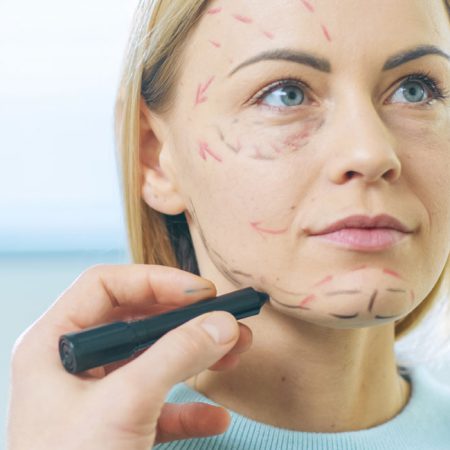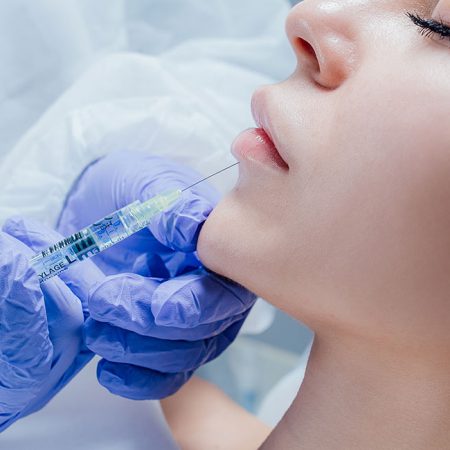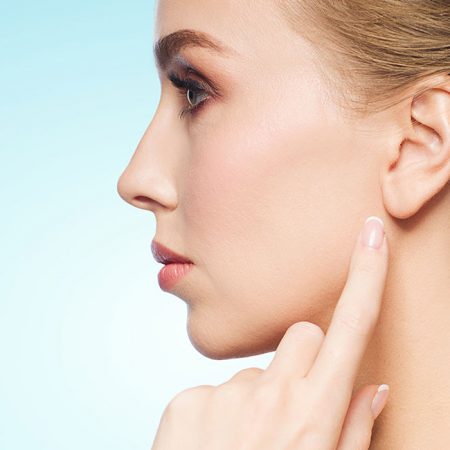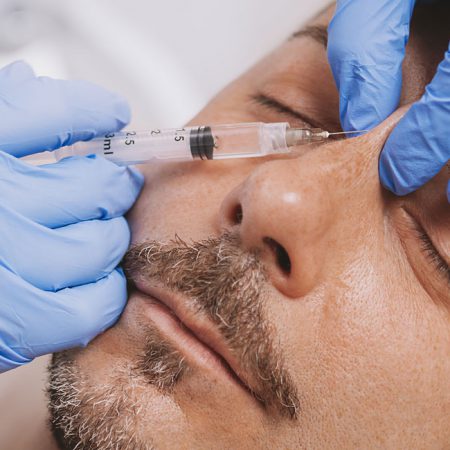Fat transfer or fat grafting surgery is minimally invasive and commonly used to increase volume in the areas of the face, buttocks or breast. Fat transfer is also used to improve body contour or symmetry. Fat transfer is an out patient procedure that is usually done under sedation with local anesthetic. Oftentimes a patient will have fat transfer done in addition to another procedure such as a facelift, in which case the patient is under general anesthesia and asleep. The fat is acquired or harvested through traditional liposuction methods from the abdomen, flanks, thighs or buttocks and then inserted back into the body with the use of a cannula and syringe.
Fat transfer in particular to the face has become a very popular method of anti aging to combat the loss of facial volume and add a more youthful tone and texture to the skin. The survival rate for fat cells is usually 70-80% for experienced surgeons. The remaining fat cells are in fact permanent (after 2-3 months) which makes fat transfer surgery a very effective procedure when compared to expensive fillers which eventually dissipate.
You can even accentuate various parts of your body and features such as your buttocks, cheeks, etc, with fat transfer. Fat transfer is a cosmetic surgical technique that transfers fat from one part of the body such as the thighs and buttocks to the area where fat is required. Fat transfer is also referred to as micro lipo-injection and fat grafting. Fat transfer allows the surgeon to provide the desired shape and smoothness to a particular body part.
How Long Does the Fat Last?
The fat transfer to face procedure can last indefinitely, although it has a tendency to dissipate over the years. Surgeons will often inject more fat than is necessary because there is an inevitable loss of some fat. How much fat dies or is reabsorbed back into the patient’s body is variable. There are so many factors that help determine the survival of fat cells after injection. Science doesn’t know precisely how the process (the biology) works regarding fat survival, but there are some mechanisms known to affect the overall success of the surgery and the survival of the adipose tissue.
Factors which affect the survival of fat tissue for fat transfer (fat grafting)
- The patient’s overall health
- Whether or not a patient is a smoker
- The technique used to extract, process and inject the fat
- Post-operative care
- The size of the graft volume (how much fat)
- Patient vascularity
Fat transfer is done in Honolulu, Hawaii by some of the world’s best cosmetic and plastic surgeons. Dr. Michael Pasquale has done his residency in plastic surgery and also completed a 2-year training certificate in cosmetic surgery from NYU Downtown, Manhattan. At his clinic at Honolulu it is ensured that clients understand the details of the procedure for fat transfer and also that they have realistic expectations of the procedure.
Fat Transfer to the Nasolabial Fold
The nasolabial fold is the crease between the side of the nose and lateral aspect of the mouth. We all have a slight fold, especially when we smile. But, with exposure to the sun and cigarette smoking, this crease can be very deep and can make you look older than your natural age. Fillers, fat transfer to the nasolabial fold, or collagen placement can be used to treat this.
Fat Transfer instead of Dermal Fillers
Artefill, Juvederm or other hyaluronic acid fillers are temporary measures. Some of the longest fillers may last up to seven years but they usually last for a much shorter period of time. You would have to replace the filler frequently, which might get expensive and inconvenient.
Fat Transfer is a better Solution
Fat transfer to the nasolabial fold is considerably more natural and has the potential to last a long time. You use fat harvested from an area of the body that is not visible and where there is a lot of fat for transfer. This includes the abdomen, thighs, hips, buttocks and upper arms. Fat is taken from these areas and processed in the laboratory. Broken fat cells, connective tissue and red blood cells are centrifuged away from the fat cells so only pure, intact fat cells are injected into the nasolabial fold.
How is Fat Transfer to the Nasolabial Fold Done?
The nasolabial fold is injected using a small needle and only small boluses of fat are transferred at a time. This is because each bolus needs to establish a blood supply and blood vessels can’t grow to supply a large bolus of fat. Many injections are made and are layered one on top of the other in a grid fashion so that the whole nasolabial fold is covered by injected globules of fat.
The use of collagen is another method of filling in the nasolabial fold. The problem with collagen is that it has an allergic potential because it is made from cows. A test spot must be done a full month before the actual procedure is done and it, too, is not a permanent solution.
Fat Transfer is the Ideal Solution to Facial Volume Loss or Wrinkles
The ideal solution to filling in the nasolabial folds is fat. It is relatively available and is an autologous substance, meaning it comes from your own body. Dermis has been tried but this is not an attractive option and is better used for scar revisions and deeper defects. Fat is liquid or semiliquid so it feels completely natural when injected. Stab incisions can be used to harvest the fat, which makes for less scarring and faster recovery. Besides the nasolabial fold, fat can be used for acne scars and enhancement of other facial areas, such as the cheeks and chin. Fat can be used for lip augmentation as well as the deep wrinkles in other parts of the face.
Fat Transfer to the Cheeks
Fat transfer is a relatively new procedure for filling out areas, including the buttocks, the breasts, around the eyes, and the cheeks. Fat is a natural product that comes from your own body so that it is impossible to be allergic to it. The biggest problem with fat transfer to any body area is that there can be fat necrosis or fat cell death because the fat cells don’t always get the circulation developed that can allow the fat to survive. With cell necrosis, there can be indentations in the affected area and dimpling can occur.
When it comes to fat transfer, cheeks are not a common area but it is a procedure that works best for those who have sunken cheeks. This can happen due to age or a great deal of weight loss. The fat transfer to cheeks takes very little fat and the area is highly vascular so that the fat takes up circulation easier than, say, the buttocks or breast.
Where Does the Fat Come From?
The procedure goes as follows: An area of the body is selected, such as the buttocks, thighs, upper arms, hips or abdomen. Fat is removed by liposuction from the donor area. One can remove extra fat so that there is a nice body contouring of that area. The fat is then taken to the laboratory, where it is centrifuged. It is centrifuged to remove red blood cells, broken fat cells and connective tissue that aren’t needed. The end result is a slurry that looks like melted butter. The fat cells are loaded into small syringes with small needles.
The cheeks are sterilized with antiseptic. The needle is inserted into the skin down to the lowest level. A small bolus of fat is injected into the tissue. Then another bolus is injected just above that and the process is repeated so that a line of boluses raises the level of the cheeks. Another area is selected and more boluses are injected. Up to a hundred or so boluses are injected to fill out the cheeks and make them look plumper.
The small boluses are necessary because a tiny bolus will accept a blood supply better than the larger bolus. There will be less fat necrosis and there will be fewer repeat visits to put more boluses into the cheeks. The end result is a plumped up cheek that looks younger and fresher than a sunken one.
Will There Be Any Scars or Big Incisions?
There are no long incisions or cuts made with fat transfer surgery in general. When the fat is transferred to the cheeks (or anywhere for that matter) a very small hole is made to accommodate the insertion of a small cannula (metal surgical tube). This small hole heals within a few days with no scarring. The only risks are bleeding, hematoma (blood clot formation), infection, swelling, or fat necrosis. Infections may need to be treated with antibiotics but the rest of the side effects will resolve spontaneously.
Other options besides fat transfer to cheeks include cheek implants and dermal fillers. These have disadvantages because one can be allergic to the fillers or to the cheek implant and there are no allergies in fat transfer to cheeks. The cheek implant can also look too obvious and can show the edges of the cheeks, depending on the thickness of the tissue overlying the implant. Fat transfer can last indefinitely but, in any event, the fat lasts longer than most fillers put into the cheek area.
Fat Transfer for Acne Scars
Many people don’t realize that fat transfer can be performed to help improve acne scarring, pock marks from acne or any scar at all. Fat transfer to the face is used for several purposes. It can be used to plump up virtually any area which is hollow or lacking in volume or plumpness. It can be used to plump lips for a more voluptuous look for example.
You Must Have fat to have fat transfer surgery
As in all fat transfer procedures, fat transfer to the face involves liposuction from another body area. These areas can include the upper arms, the abdomen, the hips, the buttocks, the back or the thighs. It is especially good to remove fat from body areas that have too much fat to begin with. If you are very thin and have only a little fat, you are not a good candidate for fat transfer because you don’t have enough donor fat.
The fat is Processed
The fat, removed by liposuction, needs to be analyzed before injection. It is sent to the laboratory and centrifuged to remove broken fat cells, red blood cells and connective tissue. What’s left is a buttery-looking smooth slurry of fat cells. The fat cells are loaded into sterile syringes that are eventually injected into the sunken area or the area that needs plumping.
The Fat Injection process
The injection process is painstaking. Only a small amount of fat is injected at a time. The cannula (metal surgical tube) is inserted as deep as it needs to go and a small bolus of fat is injected into the area. The needle is raised a bit further and another bolus is injected. As many boluses as are necessary to raise the skin up to the level it needs to go are injected. Then the doctor goes a centimeter or so away from the injection site and creates a new injection site.
Gradually, the hollow areas are filled in or the areas that need plumping begin to take shape. Often, more fat is injected than is actually necessary because some fat is absorbed by the system after being injected. This is called fat necrosis and happens when the fat globule/bolus doesn’t get a good blood supply. There is some consensus that areas of the body that don’t already contain fat will have more fat necrosis than those areas of the body that already have a layer of fat.
How Much Fat is Removed?
The amount of fat transfer required would depend upon whether the area has achieved the look and feel that is desired and the flaw rectified. The fat transfer allows the surgeon to contour the area as desired. It is used mainly for the face, buttocks and hands.
The procedure is preferred to other methods that may involve the insertion of a foreign material as in case of fat transfer the fat is taken from the individual’s body, thus negating a chance for an allergic reaction.
Fat Transfer Recovery
After fat transfer there will be some amount of discomfort and pain and the surgeon may prescribe medication to relieve the same. Pressure bandages may be applied to either or both sites to reduce the chance of blood clotting as well as swelling. The patient can return to his or her routine in a few days but would need to take things easy for at least a few weeks.
Fat transfer results in some swelling and bruising that can last from 1 to 2 weeks depending on the area injected. Some areas swell, bruise or heal more slowly than others. As with all surgery there are several factors to consider when anticipating the length of recovery or visible swelling. Your particular needs and circumstances will be evaluated by the plastic surgeon to more accurately inform you of how long you will need to rest or avoid normal activities.
Honolulu, Hawaii is an ideal place to have fat transfer done as it boasts of top quality surgical and medical facilities and also provides a great setting to recover in. Enjoy a holiday in Hawaii and return home looking younger and more attractive. Fat transfer can be done in conjunction with other cosmetic surgeries such as face-lift, laser resurfacing, etc.







